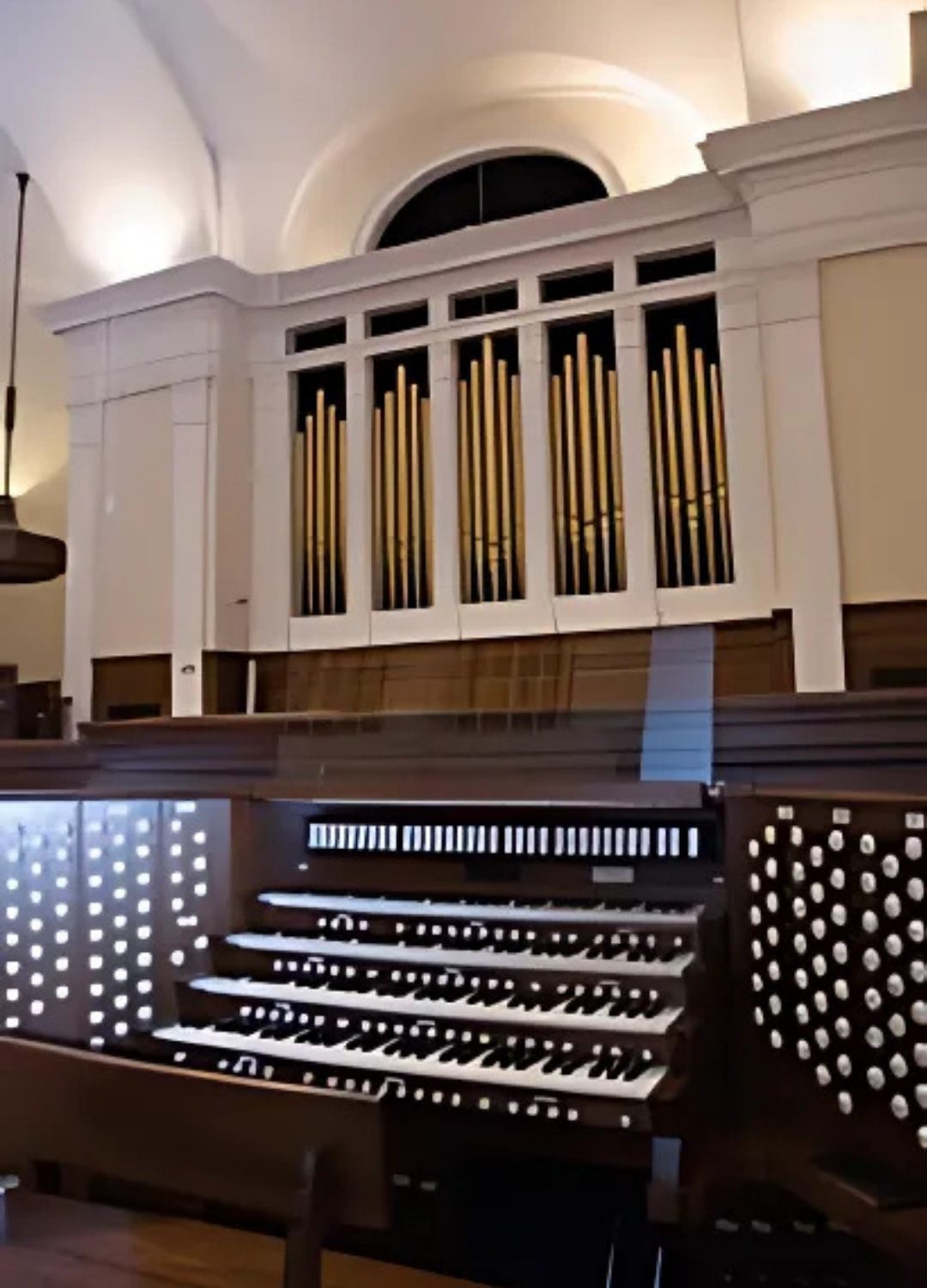
The year was 1913, and Mobile had begun an expansion westward from Catherine Street. A few Methodist families who had moved to these outskirts began to hold afternoon Sunday school classes for neighborhood children, since the closest churches were lengthy streetcar rides away. The children met in yards and on porches. Soon thereafter a committee secured permission to build a Sunday school building on a Methodist-owned lot at the southeast corner of Dauphin and Houston streets (west of the Mobile City limit at the time!). In November 1913 the Methodist Annual Conference confirmed Dauphin Way Methodist Church as a regular member and assigned it a minister in circuit with St. Stephens Road Methodist Church. The first official worship service was held on January 4, 1914, in the small, newly built wooden facility, constructed from the discarded lumber of a sawmill shed. There were 37 charter members.
The membership of the little frame church grew, and in 1922 a new four-story Sunday school building was constructed on the northwest corner of Dauphin and Catherine streets. Worship was held in the second floor auditorium, which provided space for the now combined congregations of Dauphin Way and St. Stephens Road Methodist Church, which closed in 1923. In 1925 the sanctuary was completed. Dauphin Way became a leading congregation in the Mobile community and in the Methodist Church.
By the mid-1950’s there was the need for an even larger sanctuary to accommodate the growing congregation. The legendary Dr. Carl Adkins was the minister at the time. Majestic in its simplicity, the present sanctuary on the southeast corner of Dauphin and Catherine was termed “one of Alabama’s most beautiful churches” by a Mobile Register reporter when it opened on March 17, 1957.
The architect for the Georgian building was A. Hensel Fink of Philadelphia, one of the most prominent designers of churches of the time. Dauphin Way member Peyton Higgison was the general contractor. He was married to Zell McCann, daughter of Rev. J. E. McCann, who was the minister of Dauphin Way from 1923 until 1927 (during the building of the previous sanctuary). Mr. Higgison was also the brother of Julia Hoagland, who served as Dauphin Way’s Director of Christian Education for many years. Julia’s husband Ray was the foreman on the construction of the sanctuary. That connection continues to this day with the Hoaglands’ granddaughters being active members.
Crowning the altar of the sanctuary is the magnificent stained glass window that symbolizes the Resurrection and the Great Commission, “Go therefore and make disciples of all nations.” It also reflects Dr. Adkins’ broad vision of ecumenism. It was designed and fabricated by Dr. Henry Lee Willet and the famed Willet Glass Studios of Pittsburg, Pennsylvania. The window was made possible through the generosity of the Adams, Little, and McGowin families of the church.
In 2004 a thorough renovation of the sanctuary was undertaken. During the renovation, chandeliers, which were in the original plan but were not included in 1957, were added. All of the pews were removed and refinished and re-installed after new flooring was laid. When the tile and carpet were taken up, and before the new materials, including marble in the chancel area, were installed, members and staff wrote verses of scripture over all the subflooring, adding another spiritual dimension to the majesty of our church home. The organ was totally rebuilt by the Quimby Organ Company, employing elements of the 1957 Reuter organ. It now has 71 ranks and an antiphonal component in the balcony.
The Adkins Chapel to the east of the sanctuary was built in 1982 as a memorial to the Rev. Dr. A. Carl Adkins, beloved minister of Dauphin Way from 1941 until his death in 1966. The architect was Mobilian Dillon March of March & March Architects, and the contractor was Tom Ollinger of Ollinger Construction, Inc. The three stained glass windows in the chapel are also the work of the Willet Stained Glass Studios. Each is a teaching window with appropriate verses of scripture included in the designs. The central window, a memorial to Louise and Frank Ellis given by their children, portrays Jesus preaching in the synagogue at Nazareth. The youth window to the right was placed in memory of Charles and Mamie Waller by their four sons. The children’s window to the left was given in loving memory of Christopher Stanton MacDonald by his family.
Other buildings on the campus are the Anna Marie Delchamps Education Building (1965), dedicated to the memory of the mother of the generous Delchamps family; the Lillian C. McGowin Activity Center (1982) made possible in part through the generosity of charter member Lillian Culpepper McGowin; and the Annie Delchamps Moore Family Life Center (1988), which is used for recreation and as a contemporary worship space. The columbarium garden adjacent to the education building was added in 2015.
Dauphin Way United Methodist Church’s pipe organ is a four-manual and pedal instrument containing 71 ranks of pipes. The pipe organ is designed to fulfill a wide range of musical and liturgical functions. The instrument is not intended to copy any one particular school or period of pipe organ building, but rather to be capable of playing the wide-range of liturgical requirements in worship, and music from all periods and national schools. The tonal specification was drawn up by Michael Quimby in consultation with Colleen Kelsey Hicks, Organist.
The casework, is matched to the classical architecture of the church. In particular, the casework of the Antiphonal division is modeled on the Greek revival cases produced in the middle of the nineteenth century by American organ builders such as the Hook Brothers of Boston. Tonally the instrument is unusual in a number of ways. First, it has four enclosed manual divisions. Secondly, the 32′ and 16′ reed ranks are full-length. There are no “digital” electronic ranks. The instrument contains certain features of the “Symphonic” style of pipe organ, prized in the early twentieth century, which Quimby Pipe Organs has played a leading part in reviving and developing over the last decade. For the first time in a new instrument by Quimby Pipe Organs, the Dauphin Way United Methodist Church pipe organ has revived the use of the Flared Gamba stop similar to those used by the legendary pipe organ builder Ernest M. Skinner. There is a matching Flared Gamba Celeste stop, and indeed the instrument contains a total of five Celeste stops, a feature generally confined to instruments more than double the size.

Another significant feature is the chorus reeds of the Trumpet family and orchestral reeds which include the Tuba, French Horn, English Horn, Oboe, and Clarinet voiced by Quimby Pipe Organs Inc. Of special interest are the two contrasting large solo reeds of the Trumpet family, the Tuba and Harmonic Trumpet ranks, voiced on 20″ and 10″ wind pressure and were constructed and voiced in our workshop. Unlike many pipe organs of “Symphonic” design each division of the instrument features a complete Diapason chorus that is designed to be equally versatile with classical, romantic, and symphonic styles of music. A significant feature of the Diapason chorus ranks is the unusually thick metal required to ensure stability of pipe speech, and to achieve the optimum harmonic development. The instrument incorporates 27 ranks from the previous 1956 Reuter pipe organ which have been revoiced and rescaled to function with the new tonal specification. The fine acoustics of the church significantly enhance the voicing in ways that cannot be achieved in a worship space with no acoustical ambience.
The mechanism features Quimby Pipe Organs’ version of the Blackinton slider windchest with pneumatic pallets, allowing the flue pipes of each division to speak to their optimum on common wind channels. There are electro-pneumatic pouch style windchests for all reeds except for the Choir 8′ Clarinet and extended ranks. The four-manual and pedal solid walnut drawknob console, built by Quimby Pipe Organ associates, is in the Aeolian-Skinner style and features the latest in solid-state control systems.
Associates of Quimby Pipe Organs, Inc. who made significant contributions to the construction and installation of this instrument were: Mark Cline, Bart Colliver, Tim Duchon, Chris Emerson, Charles Ford, Rubin Frels, Eric Johnson, Wes Martin, Brad McGuffey, J. O. Love, Joseph Nielsen, Michael Quimby, Janille Rehkop, Brad Richards, Michael Shields, Jim Schmidt, John Speller, Chirt Touch, and Rathana Touch.
Quimby Pipe Organs, Inc., located in Warrensburg, Missouri, has specialized in the building, rebuilding, tuning and servicing of pipe organs for 38 years. The company has a national reputation and examples of their work may be found throughout the United States. The firm additionally maintains a tuning and maintenance service throughout the Midwest and in other locations where QPO has built and rebuilt instruments.
Michael Quimby, organ builder, is a graduate of the University of Central Missouri (formerly Central Missouri State University), Warrensburg, Missouri, where he received a Bachelor of Music Education degree in 1973, and a Master of Arts degree in music history and literature with applied emphasis in organ in 1975. Mr. Quimby is a member of Pi Kappa Lambda national honor society of music and the American Institute of Organ Builders (AIO), of which he has served as president. Additionally, he has served on the Board of Directors and has also chaired the AIO Ethics Committee. His firm is presently serving a four-year term as President of the Associated Pipe Organ Builders of America. He is a member of the American Guild of Organists, having served as dean of the Greater Kansas City Chapter; the Organ Historical Society; and the International Society of Organ Builders. Mr. Quimby presently serves as organist at First United Methodist Church in Warrensburg, Missouri.
GREAT ORGAN – Enclosed (Flues 5½” Wind, Reeds 6½” Wind) – 15 Ranks
SWELL ORGAN – Enclosed (Flues 5½” Wind, Reeds 6½” Wind) – 22 Ranks
CHOIR ORGAN – Enclosed (5½” Wind) – 13 Ranks
SOLO ORGAN Enclosed (Flues and English Horn 10″ Wind; Tuba and French Horn 20″ Wind) – 7 Ranks
PEDAL ORGAN (Flues 5½, 6½, Reed 6½” Wind) – 7 ranks
ANTIPHONAL ORGAN (Flues 4½”, Reed 10″ Wind) – 7 Ranks
ANTIPHONAL PEDAL
RANK ANALYSIS
COUPLERS
COMBINATION ACTION Peterson ICS 4000, 256 levels of memory
CRESCENDO AND EXPRESSION PEDALS
REVERSIBLES
MIDI
Dauphin Way United Methodist Church

